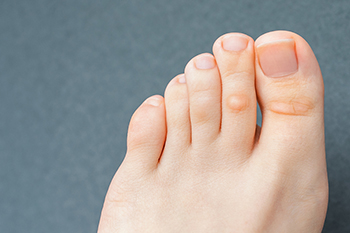March 2022
Corns Can Be In Two Places on the Foot
 Pain can often accompany a corn on the foot. A hard corn is defined as a small, toughened area that develops on top of the toes. It generally forms due to wearing shoes that do not fit correctly. The shoes may be too tight, and this can cause friction as the toes rub against the top of the shoes. A soft corn forms between the toes and is generally moist a majority of the time. Mild relief may be found when a protective covering is worn on top of the corn, or in between the toes. This can help to cushion and protect the corn as daily activities are completed. It is suggested to refrain from wearing high heels with an existing corn, in addition to limiting the amount of walking. If you have developed a corn, please speak to a podiatrist who can recommend proper removal techniques.
Pain can often accompany a corn on the foot. A hard corn is defined as a small, toughened area that develops on top of the toes. It generally forms due to wearing shoes that do not fit correctly. The shoes may be too tight, and this can cause friction as the toes rub against the top of the shoes. A soft corn forms between the toes and is generally moist a majority of the time. Mild relief may be found when a protective covering is worn on top of the corn, or in between the toes. This can help to cushion and protect the corn as daily activities are completed. It is suggested to refrain from wearing high heels with an existing corn, in addition to limiting the amount of walking. If you have developed a corn, please speak to a podiatrist who can recommend proper removal techniques.
Corns can make walking very painful and should be treated immediately. If you have questions regarding your feet and ankles, contact the podiatrists of New England Family Foot Care. Our doctors will treat your foot and ankle needs.
Corns: What Are They? And How Do You Get Rid of Them?
Corns are thickened areas on the skin that can become painful. They are caused by excessive pressure and friction on the skin. Corns press into the deeper layers of the skin and are usually round in shape.
Ways to Prevent Corns
There are many ways to get rid of painful corns such as:
- Wearing properly fitting shoes that have been measured by a professional
- Wearing shoes that are not sharply pointed or have high heels
- Wearing only shoes that offer support
Treating Corns
Although most corns slowly disappear when the friction or pressure stops, this isn’t always the case. Consult with your podiatrist to determine the best treatment option for your case of corns.
If you have any questions please feel free to contact our office located in Milton, MA . We offer the newest diagnostic and treatment technologies for all your foot and ankle needs.
Athletes and Plantar Fasciitis
 The thick band of tissue that is found on the sole of the foot is known as the plantar fascia. It connects the heel to the toes, and acts as a shock absorber, in addition to providing support to the arch. When the plantar fascia becomes irritated, plantar fasciitis may develop. This can cause pain and discomfort, and the pain may be more severe in the morning after arising. Athletes who develop this condition are often unhappy about it, and it may limit running. It can help to wear supportive footwear, and many athletes gradually increase training. There are specific stretches that can be performed which can help the symptoms of plantar fasciitis. If you would like more information about the causes and treatment of plantar fasciitis, please consult with a podiatrist.
The thick band of tissue that is found on the sole of the foot is known as the plantar fascia. It connects the heel to the toes, and acts as a shock absorber, in addition to providing support to the arch. When the plantar fascia becomes irritated, plantar fasciitis may develop. This can cause pain and discomfort, and the pain may be more severe in the morning after arising. Athletes who develop this condition are often unhappy about it, and it may limit running. It can help to wear supportive footwear, and many athletes gradually increase training. There are specific stretches that can be performed which can help the symptoms of plantar fasciitis. If you would like more information about the causes and treatment of plantar fasciitis, please consult with a podiatrist.
Plantar fasciitis can be very painful and inconvenient. If you are experiencing heel pain or symptoms of plantar fasciitis, contact the podiatrists from New England Family Foot Care. Our doctors can provide the care you need to keep you pain-free and on your feet.
What Is Plantar Fasciitis?
Plantar fasciitis is the inflammation of the thick band of tissue that runs along the bottom of your foot, known as the plantar fascia, and causes mild to severe heel pain.
What Causes Plantar Fasciitis?
- Excessive running
- Non-supportive shoes
- Overpronation
- Repeated stretching and tearing of the plantar fascia
How Can It Be Treated?
- Conservative measures – anti-inflammatories, ice packs, stretching exercises, physical therapy, orthotic devices
- Shockwave therapy – sound waves are sent to the affected area to facilitate healing and are usually used for chronic cases of plantar fasciitis
- Surgery – usually only used as a last resort when all else fails. The plantar fascia can be surgically detached from the heel
While very treatable, plantar fasciitis is definitely not something that should be ignored. Especially in severe cases, speaking to your doctor right away is highly recommended to avoid complications and severe heel pain. Your podiatrist can work with you to provide the appropriate treatment options tailored to your condition.
If you have any questions please feel free to contact our office located in Milton, MA . We offer the newest diagnostic and treatment technologies for all your foot and ankle needs.
Baby’s First Shoes and Walking
 Many parents choose to have their babies wear shoes, despite the fact that research has indicated that shoes are unnecessary to wear until walking begins. At this time, the first shoes often consist of having a flexible and non-slip sole, in addition to fitting correctly. The shoe is ideal when it fits securely on the foot. This can be helpful in preventing stubbed toes, splinters, or broken toenails. There are certain foot conditions that children can develop that require the expertise of a podiatrist. If your child has ingrown toenails, walks on their toes, or doesn’t walk by 15 months, it is suggested that you schedule an appointment with a podiatrist.
Many parents choose to have their babies wear shoes, despite the fact that research has indicated that shoes are unnecessary to wear until walking begins. At this time, the first shoes often consist of having a flexible and non-slip sole, in addition to fitting correctly. The shoe is ideal when it fits securely on the foot. This can be helpful in preventing stubbed toes, splinters, or broken toenails. There are certain foot conditions that children can develop that require the expertise of a podiatrist. If your child has ingrown toenails, walks on their toes, or doesn’t walk by 15 months, it is suggested that you schedule an appointment with a podiatrist.
Making sure that your children maintain good foot health is very important as they grow. If you have any questions, contact the podiatrists of New England Family Foot Care. Our doctors can provide the care you need to keep you pain-free and on your feet.
Keeping Children's Feet Healthy
Having healthy feet during childhood can help prevent medical problems later in life, namely in the back and legs. As children grow, their feet require different types of care. Here are some things to consider...
Although babies do not walk yet, it is still very important to take care of their feet.
Avoid putting tight shoes or socks on his or her feet.
Allow the baby to stretch and kick his or her feet to feel comfortable.
As a toddler, kids are now on the move and begin to develop differently. At this age, toddlers are getting a feel for walking, so don’t be alarmed if your toddler is unsteady or ‘walks funny’.
As your child gets older, it is important to teach them how to take care of their feet.
Show them proper hygiene to prevent infections such as fungus.
Be watchful for any pain or injury.
Have all injuries checked by a doctor as soon as possible.
Comfortable, protective shoes should always be worn, especially at play.
If you have any questions please feel free to contact our office located in Milton, MA . We offer the newest diagnostic and treatment technologies for all your foot and ankle needs.
Wounds That Don't Heal Need to Be Checked
Ways to Lower the Risk of a Running Injury
Runners understand the joy the sport brings, however, they are also aware of the possible pain that can come with the activity as well. About 70 percent of all runners injure themselves each year. They may run too fast, too far, or too soon after a previous injury. Luckily, a number of simple guidelines can keep runners on the move. If you are new to running, it’s wise to take it in phases that include walk-run activity. Try not to increase your activity more than 10 percent a week, and try to avoid running more than 45 miles per week, because after that distance, injury is more likely to occur. It’s important to listen to your feet and avoid running through pain. Give your feet and legs a chance to heal before renewing activity. Find running shoes that fit your feet well and cushion your heels, and get new ones after 500 miles. Finally, there are a number of stretching and strengthening exercises you can do to help avoid injuries. If you run consistently, it’s a good idea to plan regular visits with a podiatrist, who can examine your feet, identify any problems, and make custom orthotics as needed.
Exercising your feet regularly with the proper foot wear is a great way to prevent injuries. If you have any concerns about your feet, contact the podiatrists of New England Family Foot Care. Our doctors will treat your foot and ankle needs.
How to Prevent Running Injuries
Many common running injuries are caused by overuse and overtraining. When the back of the kneecap starts wearing out and starts causing pain in your knee, this is commonly referred to as runner’s knee. Runner’s knee is a decrease in strength in your quadriceps and can occur if you’re not wearing properly fitted or supporting shoes. To prevent runner’s knee, focusing on hip strengthening is a good idea, as well as strengthening your quads to keep the kneecaps aligned.
What Are Some Causes of Running Injuries?
- One cause of a common running injury is called iliotibial band syndrome.
- Plantar fasciitis is also another common injury.
- Stress fractures can occur from overtraining, lack of calcium, or even your running style.
Best Ways to Prevent Running Injuries
- Wear footwear that fits properly and suits your running needs.
- Running shoes are the only protective gear that runners have to safeguard them from injury.
- Make a training schedule. Adding strengthening exercises as well as regular stretching can help keep you strong and limber and can lessen the possibility of injuries.
- Stretching keeps muscles limber; this will help you gain better flexibility.
If you have any questions please feel free to contact our office located in Milton, MA . We offer the newest diagnostic and treatment technologies for all your foot and ankle needs.
Various Causes of Heel Pain
Podiatrists treat many types of disorders that cause pain in various parts of the heel. The most common heel pain is caused by plantar fasciitis (inflammation of the plantar fascia tissue), which causes pain on the bottom of the foot. Other common sources of heel pain include a calcaneal (heel bone) fracture, heel pad syndrome (a wearing down of the cushion on the bottom of the heel), nerve entrapment, including tarsal tunnel syndrome (which can also cause tingling, numbness or burning), neuromas (nerve swelling), and Achilles tendinopathy (damage to the tendon that attaches to the heel bone). Growing children may also be prone to Sever’s disease, which is irritation in the growth plate of the heel. If you have heel pain, it is suggested that you see a podiatrist. They will typically begin their evaluation by asking where the pain is located in the heel, along with medical history questions, followed by a physical examination. They may also use various diagnostic tools to determine the underlying cause of your heel pain and how best to treat it.
Many people suffer from bouts of heel pain. For more information, contact the podiatrists of New England Family Foot Care. Our doctors can provide the care you need to keep you pain-free and on your feet.
Causes of Heel Pain
Heel pain is often associated with plantar fasciitis. The plantar fascia is a band of tissues that extends along the bottom of the foot. A rip or tear in this ligament can cause inflammation of the tissue.
Achilles tendonitis is another cause of heel pain. Inflammation of the Achilles tendon will cause pain from fractures and muscle tearing. Lack of flexibility is also another symptom.
Heel spurs are another cause of pain. When the tissues of the plantar fascia undergo a great deal of stress, it can lead to ligament separation from the heel bone, causing heel spurs.
Why Might Heel Pain Occur?
- Wearing ill-fitting shoes
- Wearing non-supportive shoes
- Weight change
- Excessive running
Treatments
Heel pain should be treated as soon as possible for immediate results. Keeping your feet in a stress-free environment will help. If you suffer from Achilles tendonitis or plantar fasciitis, applying ice will reduce the swelling. Stretching before an exercise like running will help the muscles. Using all these tips will help make heel pain a condition of the past.
If you have any questions please contact our office located in Milton, MA . We offer the newest diagnostic and treatment technologies for all your foot and ankle needs.







